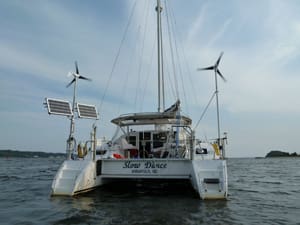To the editor: A brisk wind’s moaning in the rigging woke me at midnight. My first thought was, “Is the boat still secure — is the anchor holding?” I went out to the cockpit. The wind was surely up and the boat was bouncing in a short but active sea. A pitch black night, I could make out the faint outlines of a few hulls. I confirmed that Slow Dance’s position relative to nearby boats had not changed, pleased that my new Spade anchor was performing “as advertised.”
I turned on the instruments. We were pointed north and we had over 50 feet of water under our keel. The wind was 16 to 18 knots and gusting to more than 20. We had similar conditions two nights ago and hadn’t budged, so I would have been totally at ease if we had 150 feet of rope out in addition to our 50 feet of chain. This would have given us almost a 4 to 1 ratio of rode to depth which would have been sufficient. Unfortunately, as I had learned on my July 4th holiday visit three weeks ago, boat owners at Block Island, R.I., seem content with a only 1 to 1 or 2 to 1 scope ratio and I had to conform or run the risk of fouling my anchor tackle with that of nearby boats.
But I took some precautions. I checked the anchor bridle for chafe and made sure the lines were fast about their cleats. I opened a cockpit locker to turn the engine’s battery switch to “On,” thereby enabling a quick startup. I turned on my anchor light. I also got my high-powered spotlight out of a locker and plugged it into its cockpit outlet, should an emergency arise. I shined the light on the nearby boats to confirm their identity and my sense that we had not moved. Finally, the dinghy hung from the davits by a single line, so I added a second line in case. Then I went to sleep.
A “THUMP!” that vibrated throughout the boat woke me at 0400. I hurried to the cockpit thinking, “I knew it could happen! — I dragged and crashed into someone!!” In the cockpit I saw I was alongside a large sailboat, the hulls rubbing together. I ran forward and saw a woman on the bow of the other boat grabbing at Slow Dance’s lifelines, apparently attempting to keep the boats together. I grabbed her boat’s lifelines. She shouted, “Our anchor pulled!”
I realized this other boat had dragged anchor and drifted down on me. I could see its slack anchor line. It still had another anchor mounted on its bow, which was banging against my toe rail and was about to eat the lifelines and their supporting stanchions for breakfast as it slid down the length of my boat. I pulled harder on the other boat’s lifelines, attempting to halt the slide. A man appeared and shouted, “You’re dragging!” I cried, “No, you are! Get me a line to secure your boat!” The boats began to move apart despite our efforts. With her feet hooked in her own lifelines and her hands grasping those on my boat, the woman was soon stretched arc-like across the widening gap separating the boats.
The man reappeared to thrust the end of a line at me. I took a wrap around my bow cleat and was able to pull the hulls back together. We thrust fenders between the hulls. We then ran two more lines between the boats and adjusted lines and fenders so that the boats could ride together.
The man introduced himself as David Cross and apologized for initially stating that Slow Dance had run down on their vessel, and said his insurance would pay for the damage to my boat. With the boats now “safely joined at the hip,” we all retired as a red sun poked over the horizon at 0530.
Several hours later we all met topsides. David’s wife Libby introduced herself and dog Brody. The Crosses were high school sweethearts and have been married for 42 years. They purchased Peregrine, a Catalina 42 MK II, this spring in, of all places, Brunswick, Ga., where I had spent three of the past four-and-a-half years. A monohull with customary lead keel, Peregrine had to be two to three times the weight of my 36-foot catamaran.
I asked David what ground tackle they were using. He pointed at the sharp-pointed Delta on his boat’s anchor pulpit and said it had been their primary anchor with 100 feet of chain plus three-strand nylon, but that when they first tried to anchor here several days ago they found it couldn’t hold in the soft mud. They had resorted to their Bruce which had set readily with only 10 feet of chain attached and then nylon. It was that rig which had failed them during the night.
I told him Slow Dance came with a Bruce which I had down-graded to secondary status and replaced with a Spade. With that anchor having so recently saved his bacon, I was not surprised when David said his next purchase would be a Spade.
We surveyed my boat for damage. We found only one bent stanchion and several feet of chewed lifeline. I told David I could straighten the stanchion myself and that the lifeline was due for replacement anyway, so he should forget about any reparations.
We retrieved Peregrine’s anchor using Slow Dance’s hand windlass. The Bruce rose cradling a mound of very soft mud.
David and Libby were headed for Newport, R.I., and plan to cruise in Maine in August. They will then head for the Bahamas and points farther south.
————–
Lynn Hall, retired from the financial industry, lives aboard his PDQ 36 catamaran Slow Dance.

